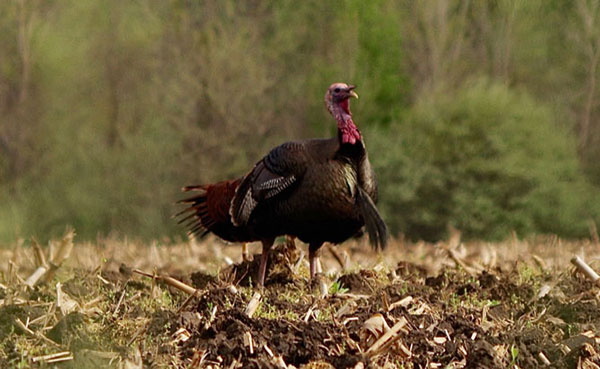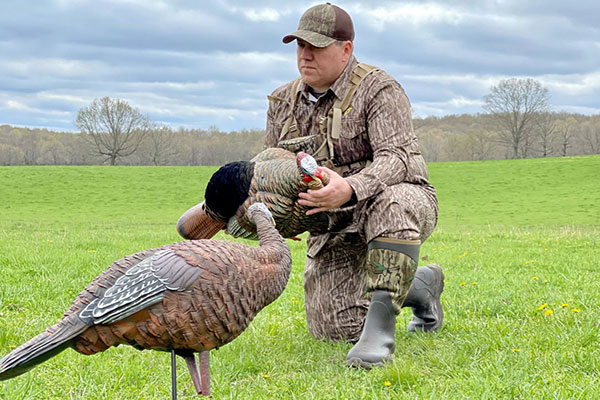By Heath Wood
 Wild Turkey
Wild Turkey
Nothing excites a turkey hunter more than the sound of a majestic gobble echoing through the air. For many, hearing this sound – or actively calling in order to get a tom to make it – is considered essential to success in the turkey-hunting game. No doubt, calling is a crucial part of most successful hunts, but the setup itself is what actually creates -- or robs – opportunities.
Over many years of experience – both successes and failures – I’ve learned the importance of being in the right place at the right time when setting up on gobbler. Think of it as a bubble or an imaginary circle. Inside that bubble, your chances of you being able to call a gobbler in and make the shot increase significantly. Outside of that bubble, he’s much more likely to hang up or hen up. Hunters often debate how big the circle is before a gobbler locks in and commits to coming to a call; some say 100 yards, while others believe the circle is smaller at around 50 yards. Either way, one must complete a proper setup to have a chance at entering this bubble of opportunity.
Setting Up on the Roost
One of the easiest ways to get inside a gobbler’s circle of influence is setting up on him while he’s still on the roost.
Some hunters scout and observe birds the night before the hunt to determine where they may be roosted in the morning. It’s often possible to actually observe roosted birds, leaving no question where they’ll be. Either situation results in knowing where a gobbler will be – either generally or specifically – so that the hunter can set up as close as possible. Getting close to a gobbler on the roost allows the hunter to not only determine where a gobbler may pitch down to in the morning, but also a gobbler's mindset and attitude before he does. Calling can then be optimized to suit his mood.
Whether sneaking into an area where you know a tom was roosted the night before, or working your way towards a roosted bird you just heard in the morning, the number-one goal is to get as close as you can without being seen. To avoid being spotted, you must get there early and move slowly. On many occasions, I listen for the tom to gobble to confirm his location. Each time he gobbles, I ease my way closer until I feel like I could almost see him on the roost.
Once I am set up, I let the tom gobble a few times without making any calls. By staying quiet, I can determine if he has hens with him. If I am close enough to see him on the limb as the morning starts to brighten, I can verify which direction he is facing. If he has hens with him, they will be making a few sounds themselves. At this point, I’ll make one or two soft calls like a tree yelp or soft purring. By keeping my calling low key, I am simply letting him know that there is another hen roosted in the area. If the nearby roosted hens begin calling back, I’ll make a few clucks, followed by a fly-down cackle call. By making the fly-down sound, I create the illusion that I am the first hen on the ground, making him eager to fly down in my direction.
If the tom seems to have more interest in the hens, I begin calling a bit louder and mimic the exact sounds the hens are making. This often aggravates the hens enough to come to check you out, allowing the following tom to wander into shooting range.
Mid-Morning Locator Calls
When getting close to a roosted gobbler isn't an option, or things didn't seem to work out, don't worry; there are still ways to get in close after birds are on the ground.
Using a locator call is a great way to get into position without the gobbler knowing your location until you are set up inside his imaginary circle, ready to begin calling. The key is only to use a locator call such as an owl hooter, crow call, or other types of natural sounds to create a shock gobble from a nearby tom. Using a locator call can make the tom gobble, giving up his location so you can move closer. While you can accomplish the same thing with a turkey call, that might cause him come to the call at the same time you are moving towards him. This places you at a higher risk of spooking the bird.
Make sure you are dressed from head to toe in suitable camouflage clothing, such as Blocker Outdoors Shield Series Angatec apparel in Mossy Oak Bottomland, and don’t forget the head cover and gloves. Once I am completely set up as close as possible, I’ll make a few soft calls with a turkey call to let him know I’m there. He’ll think a hen has slipped in towards him, and since you’re so close, it’s an easy decision for him to come check you out.
Set Up Decoys And Wait
 Turkey Hunting Decoys
Turkey Hunting Decoys
It would be nice if calling in a big tom was as easy as simply making a few calls, but in most cases, it isn’t. When a gobbler has too many hens already with him inside his circle, or is an older bird that is harder to hunt, getting him to move to you is challenging. You’ll need to move to him and infiltrate his bubble to get his attention.
Creating a turkey decoy set up and using a ground blind can be the perfect way to create a circle that nearby toms cannot resist.
Knowing where turkeys like to go throughout the day can be beneficial when hunting dominant gobblers. Many times, turkeys go to fields or open areas during the mid or late mornings during the spring. The open areas tend to be where they will strut and show off for the hens while also having the opportunity to feed. These areas are great locations to have a ground blind set up before hunting.
INSERT DECOY IMAGE
When I can't get the proper setup early in the morning, I love going to these ground blind areas and set up a jake decoy along with one or two hen decoys; I then proceed to the blind and wait. Being in a place where turkeys naturally go makes for one of the best turkey decoy setups – if you trust your location and have patience. Try to choose high ground where your decoys will be visible from multiple directions and maximum distances. I will place a jake close to one of the hens as if he is interested in breeding her. The other hen decoy is sitting off to the side about ten yards and is there to help grab the attention of any turkey that comes into the field. This setup creates a new circle that any gobbler entering the field maybe eager to join. When he comes into the field and sees the young jake with a couple of hens, he may break his current circle and join yours.




